headlights PORSCHE 911 TURBO 2014 6.G Owners Manual
[x] Cancel search | Manufacturer: PORSCHE, Model Year: 2014, Model line: 911 TURBO, Model: PORSCHE 911 TURBO 2014 6.GPages: 300, PDF Size: 10.61 MB
Page 7 of 300
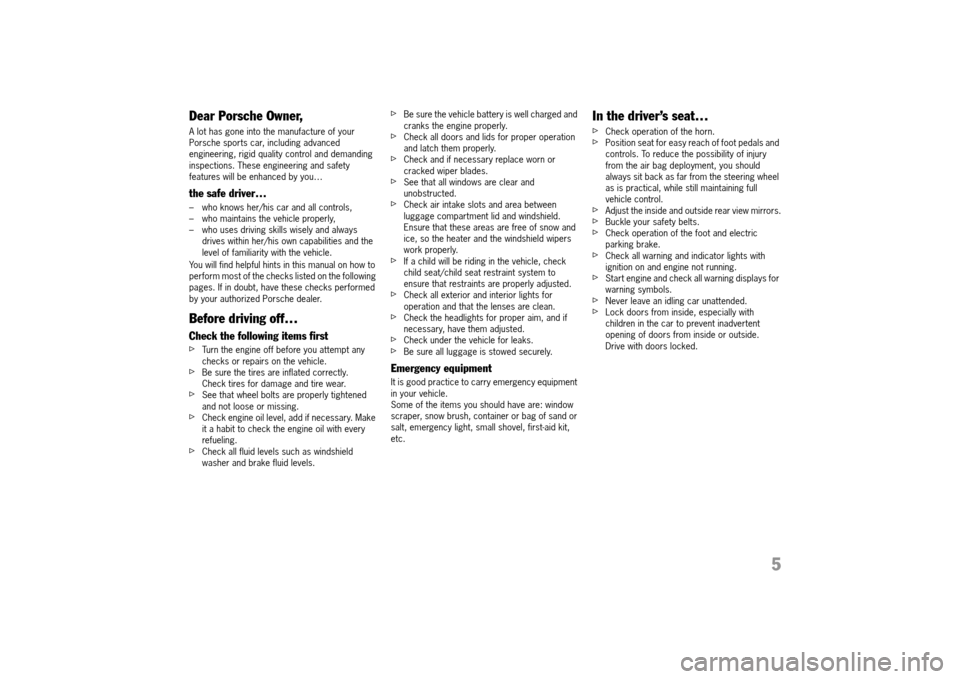
5
Dear Porsche Owner,
A lot has gone into the manufacture of your Porsche sports car, including advanced engineering, rigid quality control and demanding inspections. These engineering and safety features will be enhanced by you…
the safe driver…
– who knows her/his car and all controls,– who maintains the vehicle properly,– who uses driving skills wisely and always drives within her/his own capabilities and the level of familiarity with the vehicle.
You will find helpful hints in this manual on how to perform most of the checks listed on the following pages. If in doubt, have these checks performed by your authorized Porsche dealer.
Before driving off…
Check the following items first
fTurn the engine off before you attempt any checks or repairs on the vehicle.fBe sure the tires are inflated correctly. Check tires for damage and tire wear.fSee that wheel bolts are properly tightened and not loose or missing.fCheck engine oil level, add if necessary. Make it a habit to check the engine oil with every refueling.fCheck all fluid levels such as windshield washer and brake fluid levels.
fBe sure the vehicle battery is well charged and cranks the engine properly.fCheck all doors and lids for proper operation and latch them properly.fCheck and if necessary replace worn or cracked wiper blades.fSee that all windows are clear and unobstructed.fCheck air intake slots and area between luggage compartment lid and windshield. Ensure that these areas are free of snow and ice, so the heater and the windshield wipers work properly.fIf a child will be riding in the vehicle, check child seat/child seat restraint system to ensure that restraints are properly adjusted.fCheck all exterior and interior lights for operation and that the lenses are clean.fCheck the headlights for proper aim, and if necessary, have them adjusted.fCheck under the vehicle for leaks.fBe sure all luggage is stowed securely.
Emergency equipment
It is good practice to carry emergency equipment in your vehicle. Some of the items you should have are: window scraper, snow brush, container or bag of sand or salt, emergency light, small shovel, first-aid kit, etc.
In the driver’s seat…
fCheck operation of the horn.fPosition seat for easy reach of foot pedals and controls. To reduce the possibility of injury from the air bag deployment, you should always sit back as far from the steering wheel as is practical, while still maintaining full vehicle control.fAdjust the inside and outside rear view mirrors.fBuckle your safety belts.fCheck operation of the foot and electric parking brake.fCheck all warning and indicator lights with ignition on and engine not running.fStart engine and check all warning displays for warning symbols.fNever leave an idling car unattended.fLock doors from inside, especially with children in the car to prevent inadvertent opening of doors from inside or outside.Drive with doors locked.
14_991_Turbo_21.book Seite 5 Mittwoch, 9. April 2014 2:19 14
Page 8 of 300
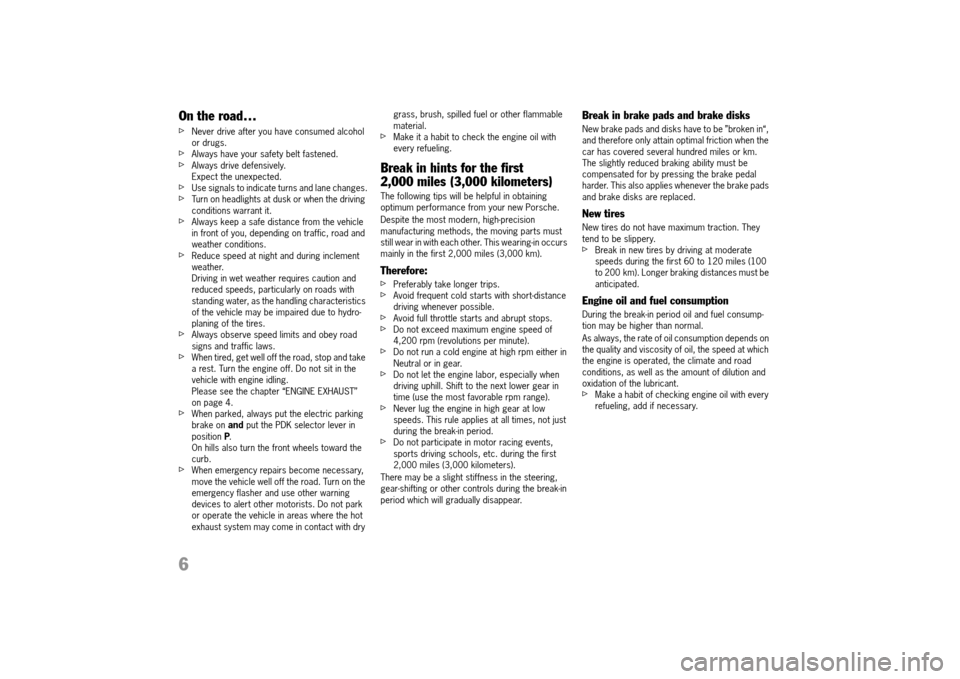
6
On the road…
fNever drive after you have consumed alcohol or drugs.fAlways have your safety belt fastened.fAlways drive defensively. Expect the unexpected.fUse signals to indicate turns and lane changes.fTurn on headlights at dusk or when the driving conditions warrant it.fAlways keep a safe distance from the vehicle in front of you, depending on traffic, road and weather conditions.fReduce speed at night and during inclement weather.Driving in wet weather requires caution and reduced speeds, particularly on roads with standing water, as the handling characteristics of the vehicle may be impaired due to hydro-planing of the tires.fAlways observe speed limits and obey road signs and traffic laws.fWhen tired, get well off the road, stop and take a rest. Turn the engine off. Do not sit in the vehicle with engine idling. Please see the chapter “ENGINE EXHAUST” on page 4.fWhen parked, always put the electric parking brake on and put the PDK selector lever in position P. On hills also turn the front wheels toward the curb.fWhen emergency repairs become necessary, move the vehicle well off the road. Turn on the emergency flasher and use other warning devices to alert other motorists. Do not park or operate the vehicle in areas where the hot exhaust system may come in contact with dry
grass, brush, spilled fuel or other flammable material.fMake it a habit to check the engine oil with every refueling.
Break in hints for the first
2,000 miles (3,000 kilometers)
The following tips will be helpful in obtaining optimum performance from your new Porsche.
Despite the most modern, high-precision manufacturing methods, the moving parts must still wear in with each other. This wearing-in occurs mainly in the first 2,000 miles (3,000 km).
Therefore:
fPreferably take longer trips.fAvoid frequent cold starts with short-distance driving whenever possible.fAvoid full throttle starts and abrupt stops.fDo not exceed maximum engine speed of 4,200 rpm (revolutions per minute).fDo not run a cold engine at high rpm either in Neutral or in gear.fDo not let the engine labor, especially when driving uphill. Shift to the next lower gear in time (use the most favorable rpm range).fNever lug the engine in high gear at low speeds. This rule applies at all times, not just during the break-in period.fDo not participate in motor racing events, sports driving schools, etc. during the first 2,000 miles (3,000 kilometers).
There may be a slight stiffness in the steering, gear-shifting or other controls during the break-in period which will gradually disappear.
Break in brake pads and brake disks
New brake pads and disks have to be ”broken in“, and therefore only attain optimal friction when the car has covered several hundred miles or km.The slightly reduced braking ability must be compensated for by pressing the brake pedal harder. This also applies whenever the brake pads and brake disks are replaced.
New tires
New tires do not have maximum traction. They tend to be slippery.fBreak in new tires by driving at moderate speeds during the first 60 to 120 miles (100 to 200 km). Longer braking distances must be anticipated.
Engine oil and fuel consumption
During the break-in period oil and fuel consump-tion may be higher than normal.
As always, the rate of oil consumption depends on the quality and viscosity of oil, the speed at which the engine is operated, the climate and road conditions, as well as the amount of dilution and oxidation of the lubricant.fMake a habit of checking engine oil with every refueling, add if necessary.
14_991_Turbo_21.book Seite 6 Mittwoch, 9. April 2014 2:19 14
Page 10 of 300
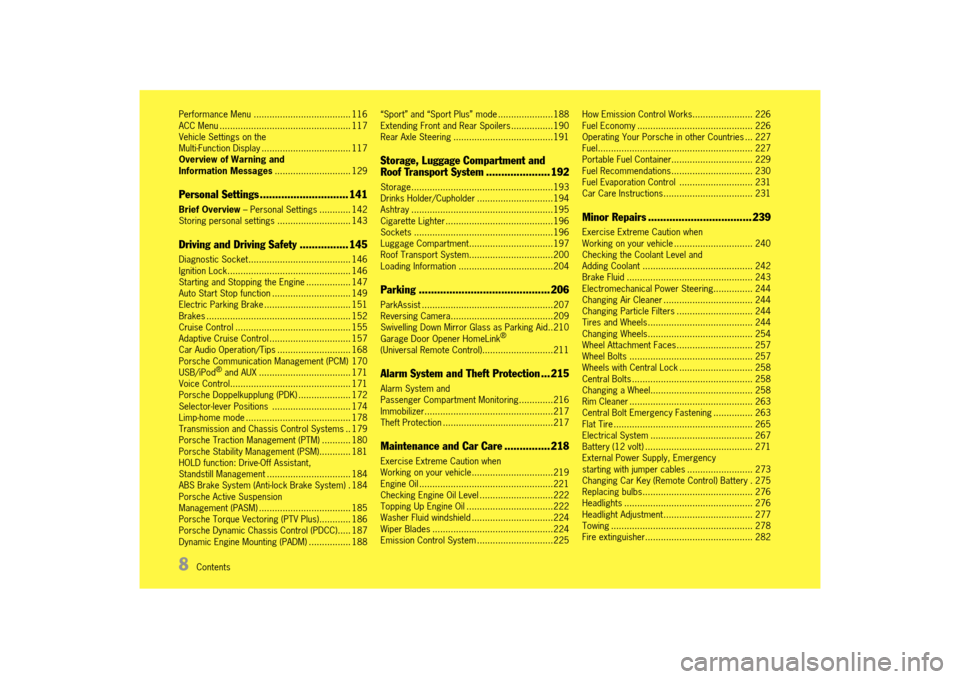
8 Contents
Performance Menu ..................................... 116 ACC Menu .................................................. 117Vehicle Settings on theMulti-Function Display .................................. 117Overview of Warning and Information Messages ............................. 129
Personal Settings ............................. 141
Brief Overview – Personal Settings ............ 142 Storing personal settings ............................ 143
Driving and Driving Safety ................ 145
Diagnostic Socket....................................... 146Ignition Lock............................................... 146Starting and Stopping the Engine ................. 147Auto Start Stop function .............................. 149Electric Parking Brake ................................. 151Brakes ....................................................... 152Cruise Control ............................................ 155Adaptive Cruise Control ............................... 157Car Audio Operation/Tips ............................ 168Porsche Communication Management (PCM) 170USB/iPod® and AUX ................................... 171Voice Control.............................................. 171Porsche Doppelkupplung (PDK) .................... 172Selector-lever Positions .............................. 174Limp-home mode ........................................ 178Transmission and Chassis Control Systems .. 179Porsche Traction Management (PTM) ........... 180Porsche Stability Management (PSM)............ 181HOLD function: Drive-Off Assistant, Standstill Management ................................ 184ABS Brake System (Anti-lock Brake System) . 184Porsche Active Suspension Management (PASM) ................................... 185Porsche Torque Vectoring (PTV Plus)............ 186Porsche Dynamic Chassis Control (PDCC)..... 187Dynamic Engine Mounting (PADM) ................ 188
“Sport” and “Sport Plus” mode .....................188 Extending Front and Rear Spoilers ................190Rear Axle Steering ......................................191
Storage, Luggage Compartment and Roof Transport System ..................... 192
Storage......................................................193 Drinks Holder/Cupholder .............................194Ashtray ......................................................195Cigarette Lighter .........................................196Sockets .....................................................196Luggage Compartment................................197Roof Transport System................................200Loading Information ....................................204
Parking ........................................... 206
ParkAssist ..................................................207Reversing Camera.......................................209Swivelling Down Mirror Glass as Parking Aid..210Garage Door Opener HomeLink®
(Universal Remote Control)...........................211
Alarm System and Theft Protection ... 215
Alarm System and Passenger Compartment Monitoring.............216Immobilizer.................................................217Theft Protection ..........................................217
Maintenance and Car Care ............... 218
Exercise Extreme Caution when Working on your vehicle...............................219Engine Oil ...................................................221Checking Engine Oil Level ............................222Topping Up Engine Oil .................................222Washer Fluid windshield ...............................224Wiper Blades ..............................................224Emission Control System .............................225
How Emission Control Works....................... 226 Fuel Economy ............................................ 226Operating Your Porsche in other Countries ... 227Fuel........................................................... 227Portable Fuel Container............................... 229Fuel Recommendations............................... 230Fuel Evaporation Control ............................ 231Car Care Instructions.................................. 231
Minor Repairs .................................. 239
Exercise Extreme Caution when Working on your vehicle .............................. 240Checking the Coolant Level and Adding Coolant .......................................... 242Brake Fluid ................................................ 243Electromechanical Power Steering............... 244Changing Air Cleaner .................................. 244Changing Particle Filters ............................. 244Tires and Wheels........................................ 244Changing Wheels........................................ 254Wheel Attachment Faces............................. 257Wheel Bolts ............................................... 257Wheels with Central Lock ............................ 258Central Bolts .............................................. 258Changing a Wheel....................................... 258Rim Cleaner ............................................... 263Central Bolt Emergency Fastening ............... 263Flat Tire ..................................................... 265Electrical System ....................................... 267Battery (12 volt) ......................................... 271External Power Supply, Emergency starting with jumper cables ......................... 273Changing Car Key (Remote Control) Battery . 275Replacing bulbs.......................................... 276Headlights ................................................. 276Headlight Adjustment.................................. 277Towing ...................................................... 278Fire extinguisher......................................... 282
14_991_Turbo_21.book Seite 8 Mittwoch, 9. April 2014 2:19 14
Page 81 of 300

Lights, Turn Signals and Windshield Wipers 79
Information
If the ignition key is removed and the door is opened while the lights are on, an audible signal (gong) warns of possible battery discharge.– In some countries, differences are possible due to legal requirements.
The vehicle’s exterior lights can mist up due to temperature and humidity. This misting will dry off after a sufficient distance has been driven.
Low beam/driving light
If the light switch is set to the position , the low beam is switched on automatically in the following situations:– Dusk– Darkness– Driving through tunnels– Rain– Highway driving (on vehicles with Porsche Dynamic Light System PDLS)
When the low beam is switched on, the indicator light on the speedometer lights up.
Information
Fog is not automatically recognized.fIn the event of fog, the driving light must be switched on manually.
Daytime driving lights
If the light switch is set to position (light off), the daytime driving lights come on automatically when the ignition is switched on.
If the light switch is set to position , the daytime driving lights come on automatically in bright conditions and when the ignition is switched on.
The daytime driving lights are not active when the light switch is set to position (low beam/driving light).
Automatic driving light assistant
The automatic driving light assistant is a comfort function. The driving light (low beam) is switched on and off automatically depending on the ambient brightness.
The automatic driving light assistant also controls the daytime driving lights, low beam, Automatic Coming Home lights and the equipment-dependent dynamic cornering light.
The automatic driving light assistant is activated when the light switch is set to the position .
Despite possible support by the driving light assistant, it is the responsibility of the driver to switch on the driving light using the conventional light switch in accordance with the relevant national regulations.
Activating the headlights using the driving light assistant therefore does not absolve the driver of responsibility for correct operation of the driving light.
Light Switch
Light is switched off
Daytime driving lights are switched on when the ignition is switched on.
Automatic driving light assistant
Side lights
License plate light, instrument lighting, daytime driving lights switched off.
Low beam/driving light
Only with ignition on. Fog light function and highway light are switched off.
Rear fog light
Pull the switch in the low beam position. Indicator light lights up.
14_991_Turbo_21.book Seite 79 Mittwoch, 9. April 2014 2:19 14
Page 88 of 300
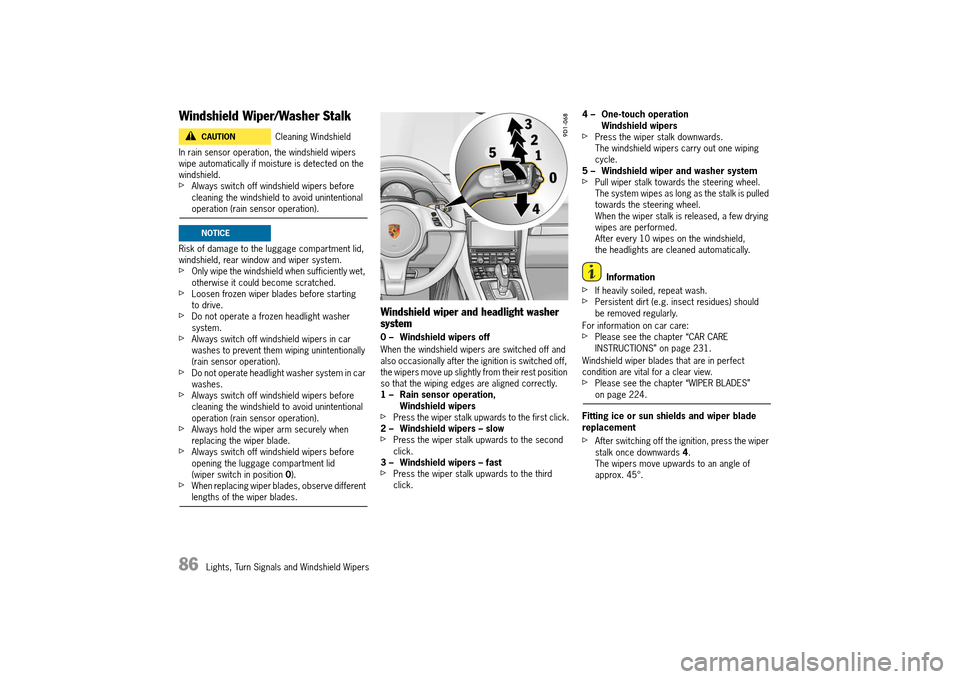
86 Lights, Turn Signals and Windshield Wipers
Windshield Wiper/Washer Stalk
In rain sensor operation, the windshield wipers wipe automatically if moisture is detected on the windshield.fAlways switch off windshield wipers before cleaning the windshield to avoid unintentional operation (rain sensor operation).
Risk of damage to the luggage compartment lid, windshield, rear window and wiper system.fOnly wipe the windshield when sufficiently wet, otherwise it could become scratched.fLoosen frozen wiper blades before starting to drive.fDo not operate a frozen headlight washer system. fAlways switch off windshield wipers in car washes to prevent them wiping unintentionally (rain sensor operation).fDo not operate headlight washer system in car washes.fAlways switch off windshield wipers before cleaning the windshield to avoid unintentional operation (rain sensor operation).fAlways hold the wiper arm securely when replacing the wiper blade.fAlways switch off windshield wipers before opening the luggage compartment lid (wiper switch in position 0).fWhen replacing wiper blades, observe different lengths of the wiper blades.
Windshield wiper and headlight washer system
0 – Windshield wipers off
When the windshield wipers are switched off and also occasionally after the ignition is switched off, the wipers move up slightly from their rest position so that the wiping edges are aligned correctly.1 – Rain sensor operation, Windshield wipersfPress the wiper stalk upwards to the first click.2 – Windshield wipers – slowfPress the wiper stalk upwards to the second click.3 – Windshield wipers – fastfPress the wiper stalk upwards to the third click.
4 – One-touch operation Windshield wipersfPress the wiper stalk downwards.The windshield wipers carry out one wiping cycle.5 – Windshield wiper and washer systemfPull wiper stalk towards the steering wheel.The system wipes as long as the stalk is pulled towards the steering wheel.When the wiper stalk is released, a few drying wipes are performed.After every 10 wipes on the windshield, the headlights are cleaned automatically.
Information
fIf heavily soiled, repeat wash. fPersistent dirt (e.g. insect residues) should be removed regularly.
For information on car care:fPlease see the chapter “CAR CARE INSTRUCTIONS” on page 231.
Windshield wiper blades that are in perfect condition are vital for a clear view.fPlease see the chapter “WIPER BLADES” on page 224.
Fitting ice or sun shields and wiper blade replacement
fAfter switching off the ignition, press the wiper stalk once downwards 4. The wipers move upwards to an angle of approx. 45°.
Cleaning WindshieldCAUTIONh
NOTICE
14_991_Turbo_21.book Seite 86 Mittwoch, 9. April 2014 2:19 14
Page 89 of 300
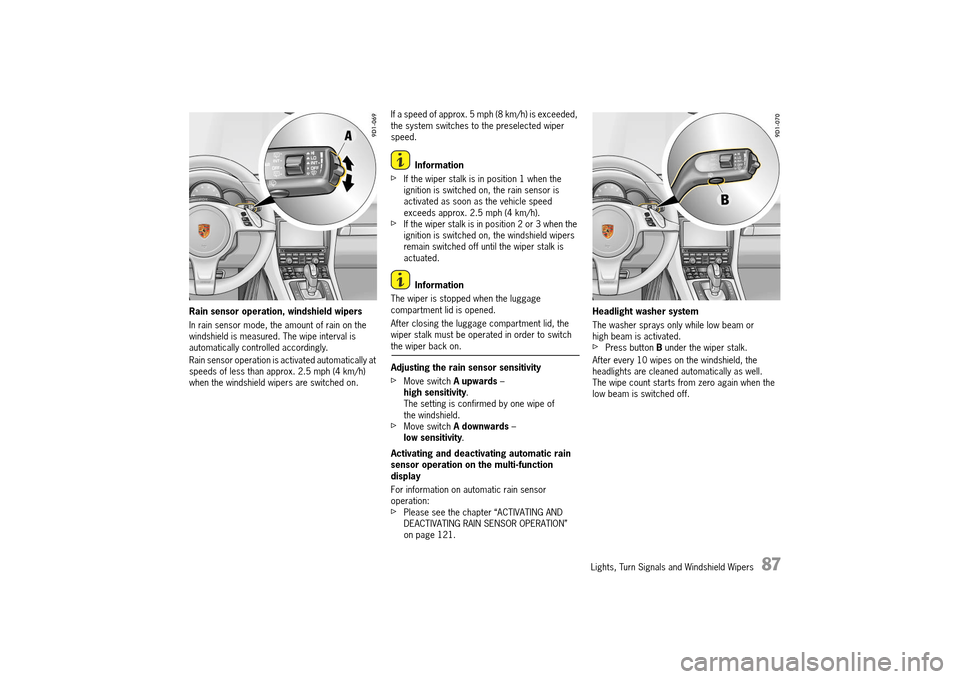
Lights, Turn Signals and Windshield Wipers 87
Rain sensor operation, windshield wipers
In rain sensor mode, the amount of rain on the windshield is measured. The wipe interval is automatically controlled accordingly.
Rain sensor operation is activated automatically at speeds of less than approx. 2.5 mph (4 km/h) when the windshield wipers are switched on.
If a speed of approx. 5 mph (8 km/h) is exceeded, the system switches to the preselected wiper speed.
Information
fIf the wiper stalk is in position 1 when the ignition is switched on, the rain sensor is activated as soon as the vehicle speed exceeds approx. 2.5 mph (4 km/h).fIf the wiper stalk is in position 2 or 3 when the ignition is switched on, the windshield wipers remain switched off until the wiper stalk is actuated.
Information
The wiper is stopped when the luggage compartment lid is opened.
After closing the luggage compartment lid, the wiper stalk must be operated in order to switch the wiper back on.
Adjusting the rain sensor sensitivity
fMove switch A upwards – high sensitivity . The setting is confirmed by one wipe of the windshield.fMove switch A downwards – low sensitivity .
Activating and deactivating automatic rain sensor operation on the multi-function display
For information on automatic rain sensor operation:fPlease see the chapter “ACTIVATING AND DEACTIVATING RAIN SENSOR OPERATION” on page 121.
Headlight washer system
The washer sprays only while low beam or high beam is activated. fPress button B under the wiper stalk.
After every 10 wipes on the windshield, the headlights are cleaned automatically as well. The wipe count starts from zero again when the low beam is switched off.
14_991_Turbo_21.book Seite 87 Mittwoch, 9. April 2014 2:19 14
Page 218 of 300

216 Alarm System and Theft Protection
Alarm System and Passenger
Compartment Monitoring
FCC Numbers :
This device complies with Part 15 of the FCC Rules and RSS-210 of Industry Canada.
Operation of this device is subject to the following two conditions:1. This device may not cause harmful interference, and 2. this device must accept any interference received including interference that may cause undesired operation.
Changes or modifications not expressly approved by the party responsible for compliance could void the user's authority to operate the equipment.
Information
The manufacturer is not responsible for any radio or TV interference caused by unauthorized modifications to this equipment. Such modification could void the user's authority to operate the equipment.
The alarm system monitors the following alarm contacts:– Alarm contacts in doors, luggage compartment lid, engine compartment lid and headlights.– Interior surveillance: Movement in the interior when the vehicle is locked, e.g. attempted theft after breaking a window.– Inclination sensor country-specific equipment: inclination of the vehicle (e.g. when attempting to tow).
If one of these alarm contacts is interrupted, the alarm horn sounds for approx. 30 seconds and the emergency flasher flashes.After 5 seconds of interruption, the alarm is triggered again. This cycle is repeated up to ten times.
Switching on
fThe alarm system is activated when the vehicle is locked.
Switching off
fThe alarm system is deactivated when the vehicle is unlocked.
Information
fIf you unlock the vehicle with the emergency key in the door lock, you must switch the ignition on (ignition lock position 1) within 10 seconds of opening the door in order to prevent the alarm system from being triggered.
Information
If button on the car key is pressed and a door or the luggage compartment lid is not opened, the vehicle is locked again automatically after 30 seconds.
Switching off the alarm system if it is triggered
fUnlock vehicle or switch on ignition.
Switching off interior surveillance and inclination sensor
If people or animals are remaining in the locked vehicle or the vehicle is being transported on, e.g. a train or ship, the interior surveillance system and inclination sensor must be switched off temporarily.fInform any persons remaining in the vehicle that the alarm system will be triggered if the door is opened.
Using the car key
fQuickly press button on the car key twice within 2 seconds.The emergency flasher flashes slowly once.The doors are locked, but can be opened from inside.
USA: KR55WK50138
Canada: 7812D-5WK50138
14_991_Turbo_21.book Seite 216 Mittwoch, 9. April 2014 2:19 14
Page 226 of 300
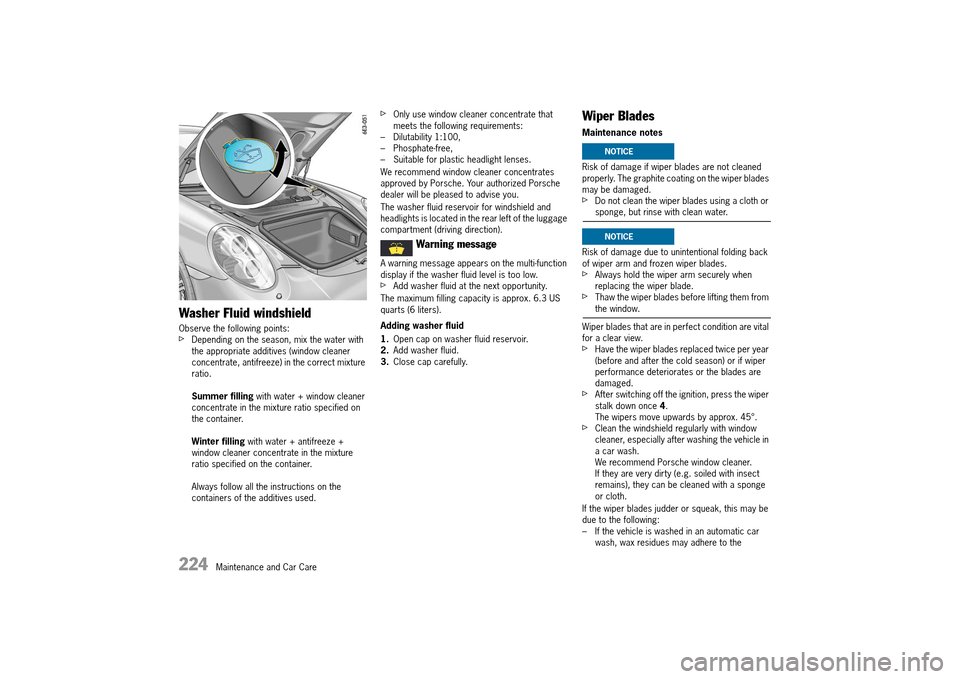
224 Maintenance and Car Care
Washer Fluid windshield
Observe the following points:fDepending on the season, mix the water with the appropriate additives (window cleaner concentrate, antifreeze) in the correct mixture ratio.
Summer filling with water + window cleaner concentrate in the mixture ratio specified on the container.
Winter filling with water + antifreeze + window cleaner concentrate in the mixture ratio specified on the container.
Always follow all the instructions on the containers of the additives used.
fOnly use window cleaner concentrate that meets the following requirements:– Dilutability 1:100,– Phosphate-free,– Suitable for plastic headlight lenses.
We recommend window cleaner concentrates approved by Porsche. Your authorized Porsche dealer will be pleased to advise you.
The washer fluid reservoir for windshield and headlights is located in the rear left of the luggage compartment (driving direction).
A warning message appears on the multi-function display if the washer fluid level is too low.fAdd washer fluid at the next opportunity.
The maximum filling capacity is approx. 6.3 US quarts (6 liters).
Adding washer fluid
1. Open cap on washer fluid reservoir. 2. Add washer fluid. 3. Close cap carefully.
Wiper Blades
Maintenance notes
Risk of damage if wiper blades are not cleaned properly. The graphite coating on the wiper blades may be damaged.fDo not clean the wiper blades using a cloth or sponge, but rinse with clean water.
Risk of damage due to unintentional folding back of wiper arm and frozen wiper blades.fAlways hold the wiper arm securely when replacing the wiper blade.fThaw the wiper blades before lifting them from the window.
Wiper blades that are in perfect condition are vital for a clear view.fHave the wiper blades replaced twice per year (before and after the cold season) or if wiper performance deteriorates or the blades are damaged.fAfter switching off the ignition, press the wiper stalk down once 4. The wipers move upwards by approx. 45°.fClean the windshield regularly with window cleaner, especially after washing the vehicle in a car wash.We recommend Porsche window cleaner. If they are very dirty (e.g. soiled with insect remains), they can be cleaned with a sponge or cloth.
If the wiper blades judder or squeak, this may be due to the following:– If the vehicle is washed in an automatic car wash, wax residues may adhere to the
Warning message
NOTICE
NOTICE
14_991_Turbo_21.book Seite 224 Mittwoch, 9. April 2014 2:19 14
Page 237 of 300
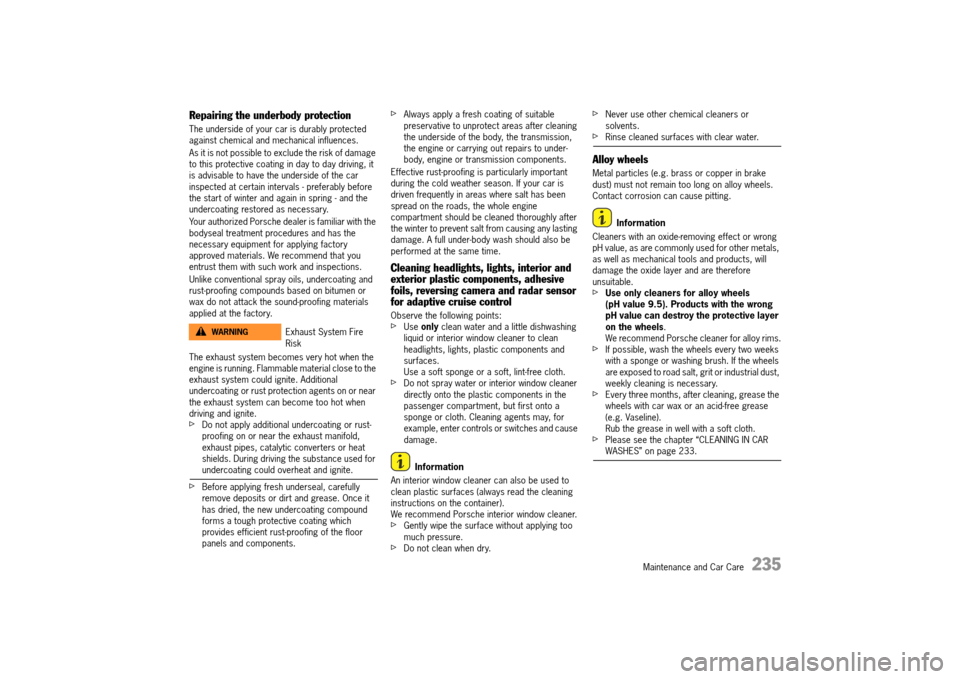
Maintenance and Car Care 235
Repairing the underbody protection
The underside of your car is durably protected against chemical and mechanical influences.
As it is not possible to exclude the risk of damage to this protective coating in day to day driving, it is advisable to have the underside of the car inspected at certain intervals - preferably before the start of winter and again in spring - and the undercoating restored as necessary.
Your authorized Porsche dealer is familiar with the bodyseal treatment procedures and has the necessary equipment for applying factory approved materials. We recommend that you entrust them with such work and inspections.
Unlike conventional spray oils, undercoating and rust-proofing compounds based on bitumen or wax do not attack the sound-proofing materials applied at the factory.
The exhaust system becomes very hot when the engine is running. Flammable material close to the exhaust system could ignite. Additional undercoating or rust protection agents on or near the exhaust system can become too hot when driving and ignite.fDo not apply additional undercoating or rust-proofing on or near the exhaust manifold, exhaust pipes, catalytic converters or heat shields. During driving the substance used for undercoating could overheat and ignite.
fBefore applying fresh underseal, carefully remove deposits or dirt and grease. Once it has dried, the new undercoating compound forms a tough protective coating which provides efficient rust-proofing of the floor panels and components.
fAlways apply a fresh coating of suitable preservative to unprotect areas after cleaning the underside of the body, the transmission, the engine or carrying out repairs to under-body, engine or transmission components.
Effective rust-proofing is particularly important during the cold weather season. If your car is driven frequently in areas where salt has been spread on the roads, the whole engine compartment should be cleaned thoroughly after the winter to prevent salt from causing any lasting damage. A full under-body wash should also be performed at the same time.
Cleaning headlights, lights, interior and exterior plastic components, adhesive foils, reversing camera and radar sensor for adaptive cruise control
Observe the following points: fUse only clean water and a little dishwashing liquid or interior window cleaner to clean headlights, lights, plastic components and surfaces.Use a soft sponge or a soft, lint-free cloth.fDo not spray water or interior window cleaner directly onto the plastic components in the passenger compartment, but first onto a sponge or cloth. Cleaning agents may, for example, enter controls or switches and cause damage.
Information
An interior window cleaner can also be used to clean plastic surfaces (always read the cleaning instructions on the container).We recommend Porsche interior window cleaner.fGently wipe the surface without applying too much pressure.fDo not clean when dry.
fNever use other chemical cleaners or solvents.fRinse cleaned surfaces with clear water.
Alloy wheels
Metal particles (e.g. brass or copper in brake dust) must not remain too long on alloy wheels.Contact corrosion can cause pitting.
Information
Cleaners with an oxide-removing effect or wrong pH value, as are commonly used for other metals, as well as mechanical tools and products, will damage the oxide layer and are therefore unsuitable.fUse only cleaners for alloy wheels (pH value 9.5). Products with the wrong pH value can destroy the protective layer on the wheels . We recommend Porsche cleaner for alloy rims.fIf possible, wash the wheels every two weeks with a sponge or washing brush. If the wheels are exposed to road salt, grit or industrial dust, weekly cleaning is necessary.fEvery three months, after cleaning, grease the wheels with car wax or an acid-free grease (e.g. Vaseline).Rub the grease in well with a soft cloth.fPlease see the chapter “CLEANING IN CAR WASHES” on page 233.
Exhaust System Fire Risk
WARNINGh
14_991_Turbo_21.book Seite 235 Mittwoch, 9. April 2014 2:19 14
Page 241 of 300

Minor Repairs 239
Minor Repairs
Exercise Extreme Caution when Working on your vehicle .............................. 240Checking the Coolant Level and Adding Coolant .......................................... 242Brake Fluid ................................................ 243Electromechanical Power Steering............... 244Changing Air Cleaner .................................. 244Changing Particle Filters ............................. 244Tires and Wheels ........................................ 244Changing Wheels........................................ 254Wheel Attachment Faces ............................. 257Wheel Bolts................................................ 257Wheels with Central Lock ............................ 258Central Bolts .............................................. 258Changing a Wheel....................................... 258Rim Cleaner ............................................... 263Central Bolt Emergency Fastening ............... 263Flat Tire ..................................................... 265Electrical System ....................................... 267Battery (12 volt) ......................................... 271External Power Supply, Emergency starting with jumper cables ......................... 273Changing Car Key (Remote Control) Battery . 275Replacing bulbs.......................................... 276Headlights ................................................. 276Headlight Adjustment .................................. 277Towing ...................................................... 278Fire extinguisher......................................... 282
14_991_Turbo_21.book Seite 239 Mittwoch, 9. April 2014 2:19 14